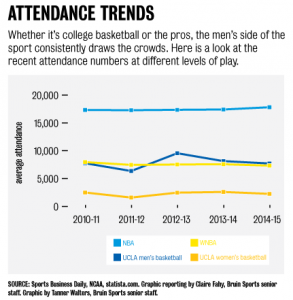Back when I played basketball, I had one move I used to employ against my little brother on the hoop outside our house. Post up, fake right, roll left, fadeaway, shoot. It worked like a dream. That is, until my little brother grew to be 6 feet tall and swatted the ball away on every single attempt.
My fadeaway jumper was one I had practiced since I was probably 5 years old. I’d seen Kobe do it, and Lebron, and Melo. I tested it out on the grade school Catholic Youth League courts and perfected it at the next level in the Bay Counties League. I couldn’t dribble or defend, but I could shoot my jumper.
Now, someone has stolen my move.
I see it in Nike commercials and Gatorade ads, on billboards and in magazines: Elena Delle Donne with that powerful spin and effortless follow through. She shoots it better – well enough to lead the WNBA in scoring with 23.4 points per game – and she could also shoot it over my little brother – Delle Donne stands at 6 feet 5 inches.
I respect Delle Donne for more reasons than just the fact she’s taken my trademark move to new heights. Along the way, she’s taking her league – and women’s basketball as a whole – to a much higher level. The Chicago Sky forward was named the 2015 WNBA MVP and also became the face of the new Nike Women’s Basketball Collection.
Your game. Your moves. #BringYourGame
https://t.co/SIILEBIFu2 pic.twitter.com/sd9mBs05HB
— Nike Basketball (@nikebasketball) December 29, 2015
That’s right. On Sept. 30, 2015, Nike released a line of basketball attire for women. Gone are the days of rolling up too-long shorts and stuffing too-big jerseys into sports bra straps. This gear is made just for women, recognizing and legitimizing our claim to the sport of basketball.
The WNBA was founded in 1996 and, although more women than ever are pursuing professional sports careers, they’re almost always treated as second-tier athletes. It’s taken 19 years to get to this point and it will take many more before female athletes are equally respected, but Delle Donne is making more than a few dents in the stereotypes that pervade women’s sports.
While Delle Donne works away, however, no one is watching. The 2015 WNBA season saw its lowest-ever attendance with an average of 7,318 spectators at each game. In 1998 – the league’s most successful year – an average of 10, 864 WNBA fans attended each matchup. The game is on an exponential rise but attendance is moving in the opposite direction.
Regardless of that stat, 2016 is the year for women’s basketball. Nike knows it. I know it. We’re leaning in and shattering glass ceilings, but now we’ve got to start watching some women’s basketball games.
Take the UCLA women’s team. These Bruins are looking to piece together one of their most successful seasons in recent history, and they aren’t alone. NCAA women’s basketball is improving across the country. While UConn, Stanford and Notre Dame are still big names, it isn’t just them anymore. Everyone is getting in on the action, with seven Pac-12 teams featured in national rankings.
On Monday, No. 15 UCLA upset No. 11 Oregon State by 20 points – the program’s first win over a ranked team in two years – in front of a crowd of 1,161. When the Bruin men’s team upset Kentucky Dec. 3, 12,202 fans filled the stands.
When UCLA women’s basketball takes the court at Pauley Pavilion Jan. 22 for its next home game, there should be no blue polyester seat left unfilled. This team is poised to make a real run in the postseason, something – let’s face it – that is still a distant dream for our men’s program. As Nike likes to say, “We are all witnesses.” So let’s be sure to witness this.
These women are achieving all the things I never could back when I was practicing my spin move in my driveway. They’re achieving things my 15-year-old brother can’t do, either. They’re making history every single night they take the floor.
All we have to do is pay attention.
Email Fahy at cfahy@media.ucla.edu or tweet her at @clairemfahy.

